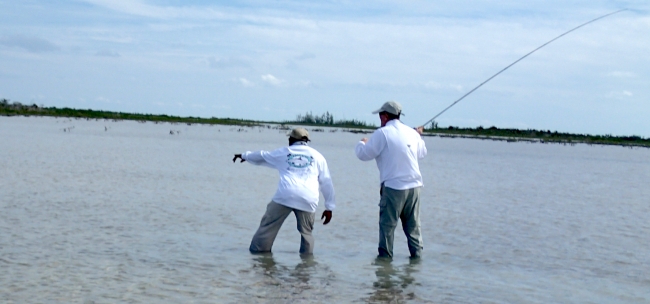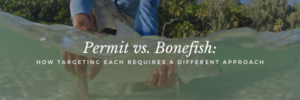When you think about dressing for a bonefishing trip, if you are a first-time angler you probably envision throwing on a simple t-shirt and shorts just before heading out the door. While this outfit makes sense for comfort, there are many other facets to consider when preparing your outfit for a successful day on the flats. This is your comprehensive dressing guide for your next Bahamas bonefishing trip!
Hat
Your choice of hat is imperative. Always wear a hat with a dark or black under-brim, this absorbs they sun’s rays rather than reflect them and allows you to spot the bonefish more easily. Sunscreen is a great way to keep the sun’s rays from harming your skin, but you’ll also need a hat for an added buffer. A baseball cap paired with a sun mask, such as Buff, can dramatically improve the protection of your face, nose, ears, and neck. If you substitute a visor for the baseball cap, just make sure you protect your scalp!
Polarized Sunglasses
A high-quality pair of polarized sunglasses (bring at least two) is essential. These will make all the difference when it comes to spotting fish not only during the brightest parts of the day, but also at lower light levels. Polarized lenses not only filter light, but also increase your visual acuity in seeing into the water. The best sunglasses, such as the 580 series from Costa Del Mar, intensify colors underwater as well as enhancing definition; allowing you to better identify fish on difficult bottoms. Amber, vermillion and copper are good choices in color, with some better in high sunlight like vermillion and copper, and others better in low light conditions like amber (yellow).You may wish to bring sunglasses in more than one color, which will give you flexibility in the differing light conditions you will encounter on our flats. Brands such as Costa del Mar and Smith Optics offer best performance and protection, but discount department stores and sporting goods chains carry polarized variants for as little as $15 if you are looking to save money.
Shirts
Choose a shirt that is light, long-sleeved, quick to dry and which includes built-in sun protection. Nylon is the preferred shirt material. These are the essential characteristics you should be looking for in a shirt. Shirts that are lighter in color tend to be the coolest, and it is best if you avoid cotton due to its inability to dry quickly. Simms, Ex-officio and Columbia all manufacture high-quality shirts in a variety of colors, and styles; including shirts with “built-in” cooling for the warmer months. Micro fiber also performs extremely well; brands such as Redzone and SWC have great selections. Do not forget to bring along a breathable, light rain coat and nylon belt as well.
Pants
Nylon “convertible” fishing pants from manufacturers such as Columbia, Simms and Ex-officio are the norm. All offer models with built-in sun protection and models which are stain-resistant. During the warmer months, jeans are not recommended. Even in the winter and early spring, cotton pants are a poor choice, especially if you will be wading. In general, substitute pants for shorts. You might be arching your eyebrows about the pants recommendation, but they truly make all the difference. As you wade in shorts for long periods of time on your Bahamas bonefishing trip, any sunscreen on your legs will gradually wash away. Once this happens, it will not take long for sunburn to set in.
Underwear
Choose your underwear wisely. Like your other garments, your underwear will need to consist of a fabric that can dry quickly. Ex-Officio has many great options for performance underwear.
Foot Protection
Lastly, bring along the right shoes and socks. While on the flats boat, many anglers prefer to fish barefoot to “feel” their line if underfoot. Another option, which will avoid sun-burning your feet, is to wear so-called “footie” socks, such as you might wear with golf shoes. Some anglers prefer to fish from the boat in sneakers or water shoes. When you leave the boat to wade for fish, wading boots that feature a closed toe are a must; no bare feet or you risk serious injury from jagged coral, or even the painful barb of a stingray. Sandals work for certain areas of the flats, but they also leave your feet exposed to jagged limestone and other hazards. Lightweight boots such as the Simms Zip-It booties or flats sneakers are recommended which offers many great selections designed for wading and protection. Always wear a pair of socks with your wading booties/sneakers, this prevents the sand from rubbing a hole through your foot and ruin your trip.
If you found this information helpful feel free to share it with your friend or leave us a comment below.








